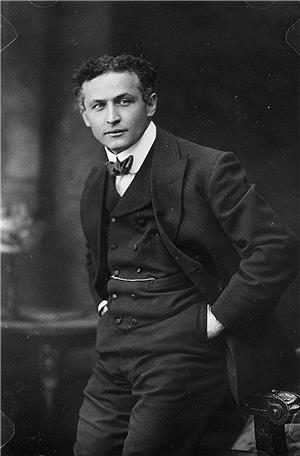On October 17, 1915, magician and master escapologist Harry Houdini (1874-1926) begins a week-long run at the Orpheum Theatre in Seattle. As part of each act, he performs the East Indian Needle Trick, and does an escape from his Chinese Water Torture Cell. While in Seattle, he also dangles from the Seattle Times building in a straightjacket, freeing himself with aplomb.
Plenty to See
By 1915, Harry Houdini (birth name Erik Weisz) was a bona fide star and one of the highest paid performers on the vaudeville circuit. Seattle's Orpheum Theatre booked him as their headliner act for the week of October 17, and each night's performance drew large crowds. Matinee tickets cost 10 and 25 cents depending on seat location, and evening shows cost 10, 25, and 50 cents.
Other acts on the bill included Dainty Marie (Marie Meeker), a singer and dancer who dressed in white tights and who performed living recreations of Rodin's statues; Robert Dailey and company, who performed the farcical skit "Our Bob"; Mabelle Lewis, a petite woman who impersonated young children in songs, joined by Paul McCarty, a strapping, athletic man, in a skit entitled "Dainty Different Doings"; The Bison City Four, who sang and performed character comedy dressed as an Irish policeman, an Italian fruit vendor, an American bartender, and a nondescript tramp; singer Elsie Fay; and the Novelty Clintons, a popular acrobatic duo well-known for their jumping and hopping expertise.
Travel films were also shown of Italy, Serbia, Brittany, Turkey, Austria-Hungary, and Hindustan. Music was provided by the Orpheum Orchestra, led by Charles "Tiny" Burnett (1888-1974). From all accounts, each act was well-received by audiences, especially the Bison City Four, who performed multiple encores. But the crowds came to see Houdini.
Needles and Pinned
Houdini's act began with seven minutes of motion pictures showing the magician in Paris, leaping handcuffed into the Seine. After the film showed him escaping his bonds, Houdini appeared on stage in a straightjacket, from which he then extricated himself,
Next up was the East Indian Needle Trick. More than 50 needles were given to the magician, along with a thread of silk, which he then appeared to swallow whole. Members of the audience were invited on stage to examine his mouth, and after verifying that it was empty he would "regurgitate" the needles, which were now threaded together.
He performed other magic tricks and sleights of hand, as well as demonstrations of how he became known as the Handcuff King. Handcuffs were placed on his wrists, and he was secured to the stage. Within a minute or so he freed himself, to the amazement of all.
Breath Taking
The highlight of Houdini's act was his famous Chinese Water Torture Cell. A large, empty water tank with glass sides was brought on stage. Houdini described it in great detail. Audience members were allowed to examine it, after which Houdini briefly left the stage to change into his swimsuit while his assistants filled the tank to the brim with water.
Returning, Houdini lay down on stage and placed his feet in stocks, which were also inspected by audience members as his feet were locked into place. Hoisted upward, he was lowered head first into the tank, where the stocks were secured to the top. He was now completely immersed in what appeared to be an air-tight container. Velvet drapes were raised around it, and the audience waited for him to escape.
One minute passed, then two. An assistant held an axe at the ready, in case of emergency. The orchestra began playing "Asleep in the Deep," and just as the audience began showing concern, Houdini emerged from behind the curtains to thunderous applause. The act was performed this way every night.
Always a Showman
During the week, Houdini publicized his act using methods that had worked from city to city. Enlisting help from the local police, ads were placed in the local newspapers issuing a challenge from King County Sheriff Bob Hodge (1875-1923). The sheriff asked Houdini to allow three local jailers to chain him to the stage using their own handcuffs and equipment, to see if he could escape. The ad noted that Houdini had accepted this challenge, with the only condition being that no straps or bindings would be drawn that could cause danger of strangulation.
Another publicity stunt involved Houdini hanging upside down from the side of a building while wrapped in a straightjacket. Crowds gathered to watch the magician free himself. From city to city, Houdini often performed this stunt from the office building of a local newspaper, to maximize press coverage. In Seattle, he dangled from the side of the Seattle Times building, while thousands watched from below. An article and photo of this act appeared in the paper the very next day.
Houdini also found some time to relax during his visit to Seattle, but even then he was a master showman. Lumber magnate C. D. Stimson (1857-1928) invited Houdini to visit The Willows, Stimson's lodge on the Squak Slough (now the Sammamish Slough) northeast of Seattle. While there, the magician spent hours entertaining Stimson and his friends with all kinds of magic tricks. At one point, Houdini asked the group to choose card from a deck. They chose the ace of spades, placed it back in the deck, which they then handed back to Houdini. He tossed the deck into the air, and all of the cards fell back to earth, save one. The ace of spades stuck to one of the ceiling beams. For years after, Stimson left it right there.

